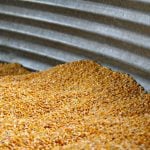The shaking over fears of a recession in the United States caused some of the money that poured into commodities in the first two weeks of 2008 to splash out last week.
It was a bad time for all financial markets with equities particularly taking it on the chin, but commodities also fell as traders worried that a slowdown in the U.S. would spread around the world and reduce demand for metal, minerals and energy.
On Jan. 21, oil dropped below $90 per barrel, down 10 percent from the record set Jan. 2.
Read Also

Why feds imposed EV tariffs
Moe and Kinew have a fight on their hands when it comes to eliminating the EV tariff. Canada has to worry about pissing off the U.S. and Mexico and hundreds of thousands of auto workers.
All this affected crop markets, but to a lesser extent than equity markets. This column last week noted the danger of a U.S. recession and the opinion of many market watchers that crop prices could hold up well because of tight supply and demand fundamentals.
The future will tell, but we might take hope from the fact that spring wheat prices rose during the turmoil Jan. 18.
U.S. markets were closed Jan. 21 for Martin Luther King day and so the reaction to several weather events, including rain in Australia and Brazil and snow in China, was not clear as the Western Producer went to press.
The weather for South America’s soybean crop has been less than ideal so far this year. Oil World’s forecast for the combined Brazil and Argentina crop is 107.3 million tonnes, up less than one million from last year. That is not enough to make up for the smaller crop in the U.S. and is a factor that supports oilseed prices.
The deterioration in the South American crop might have stopped, at least for a while, thanks to rain this weekend in Brazil and Argentina, unless the rain prompts an outbreak of Asian soybean rust.
Across the Pacific, torrential rain hit central Queensland in Australia. That’s the state in the northeastern part of the country. Good rain also recently fell farther south in the more important agricultural states of New South Wales and Victoria.
There has been flooding in Queensland, but overall the effect is positive for a country that suffered back-to-back droughts in 2006 and 2007. The rain will set up good moisture reserves for the 2008 crop to be planted in May.
This helps confirm the forecast that drought would release its grip on Australia this year and raises the probability that Australian agriculture will be a strong competitor in 2008-09.
The precipitation that fell in central China came in the form of snow. Reuters reported that about 1.4 million acres of crops had been damaged, but such early reports from China are often not clear about the true nature of such damage or the offsetting benefit of increased moisture.














